Themed collection Antibacterial Biomaterials

Introduction to Antibacterial Biomaterials
Jianfeng Cai and Runhui Liu introduce the Biomaterials Science themed issue on antibacterial biomaterials.

Biomater. Sci., 2020,8, 6812-6813
https://doi.org/10.1039/D0BM90100H
Functionalized biomaterials to combat biofilms
Pathogenic microbial biofilms that readily form on implantable medical devices or human tissues have posed a great threat to worldwide healthcare.
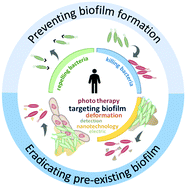
Biomater. Sci., 2020,8, 4052-4066
https://doi.org/10.1039/D0BM00526F
Amphiphilic polymer therapeutics: an alternative platform in the fight against antibiotic resistant bacteria
Amphiphilic antimicrobial polymers show promising potential as polymer therapeutics to fight drug resistant bacteria and biofilms.

Biomater. Sci., 2021,9, 2758-2767
https://doi.org/10.1039/D0BM01865A
Photothermal bactericidal surfaces: killing bacteria using light instead of biocides
Recent developments of photothermal bactericidal surfaces based on immobilized photothermal agents to kill bacteria through hyperthermia effects are reviewed.

Biomater. Sci., 2021,9, 10-22
https://doi.org/10.1039/D0BM00617C
Antibacterial nanosystems for cancer therapy
In this review, we introduce anti-bacterial nanosystems for cancer therapy in the aspects of spontaneous and triggered anti-bacterial action.
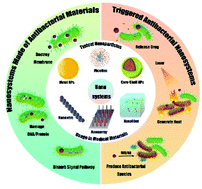
Biomater. Sci., 2020,8, 6814-6824
https://doi.org/10.1039/D0BM01537G
Emerging antibacterial nanomedicine for enhanced antibiotic therapy
This review highlights the different mechanisms of current nano-antibiotic systems for combatting serious antibiotic resistance of bacteria.
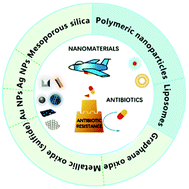
Biomater. Sci., 2020,8, 6825-6839
https://doi.org/10.1039/D0BM00974A
Design of nanoengineered antibacterial polymers for biomedical applications
This review thus provides a feasible guide to developing nanoengineered antibacterial polymers by presenting both broad and in-depth bench research, and it offers suggestions for their potential in biomedical applications.
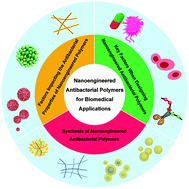
Biomater. Sci., 2020,8, 6867-6882
https://doi.org/10.1039/D0BM00788A
Tuning surface topographies on biomaterials to control bacterial infection
Bacterial growth over biomaterials can be controlled by adjusting the size, shape and composition of their surface topography.
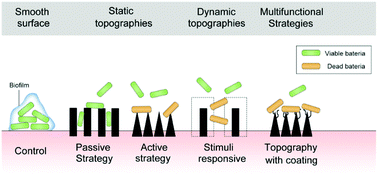
Biomater. Sci., 2020,8, 6840-6857
https://doi.org/10.1039/D0BM00845A
Role and modulation of the secondary structure of antimicrobial peptides to improve selectivity
Helix is a two-edged sword for AMPs, and conformational modulation of AMPs can control the balance between antimicrobial activity and toxicity.
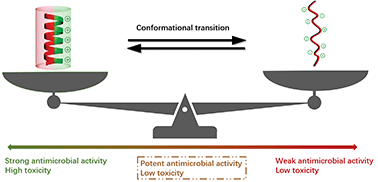
Biomater. Sci., 2020,8, 6858-6866
https://doi.org/10.1039/D0BM00801J
The recent advances in surface antibacterial strategies for biomedical catheters
This review focus on the recent advances in surface modification strategies of biomedical catheters used to prevent CRIs.
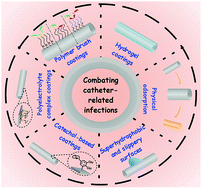
Biomater. Sci., 2020,8, 4095-4108
https://doi.org/10.1039/D0BM00659A
Dimeric lipo-α/sulfono-γ-AA hybrid peptides as broad-spectrum antibiotic agents
We report the design and investigation of a class of short dimeric antimicrobial lipo-α/sulfono-γ-AA hybrid peptides by mimicking the mechanism of action of host-defense peptides.
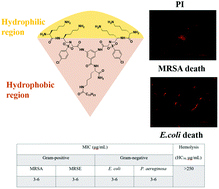
Biomater. Sci., 2021,9, 3410-3424
https://doi.org/10.1039/D0BM01955K
Synthesis and antibacterial activity of polymer–antibiotic conjugates incorporated into a resin-based dental adhesive
The dental resins incorporated with a penicillin V (PV)-based polymer–antibiotic conjugate (PAC) demonstrate significant antibacterial properties.
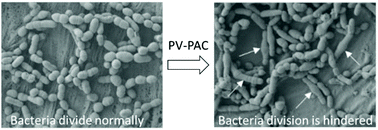
Biomater. Sci., 2021,9, 2043-2052
https://doi.org/10.1039/D0BM01910K
Smart nanomicelles with bacterial infection-responsive disassembly for selective antimicrobial applications
Electrostatic nanomicelles remain stable and biocompatible under physiological conditions, but readily burst and spill out cationic antimicrobial peptide to kill bacteria at infection sites.

Biomater. Sci., 2021,9, 1627-1638
https://doi.org/10.1039/D0BM01382J
A convenient approach for antibacterial polypeptoids featuring sulfonium and oligo(ethylene glycol) subunits
A novel type of polypeptoids containing both sulfonium and oligo(ethylene glycol) moieties were prepared, which show rapid and potent antibacterial activity as well as good hemocompatibility.

Biomater. Sci., 2020,8, 6969-6977
https://doi.org/10.1039/D0BM01384F
Conductive and antimicrobial macroporous nanocomposite hydrogels generated from air-in-water Pickering emulsions for neural stem cell differentiation and skin wound healing
Conductive and antimicrobial macroporous hydrogels have shown promising applications in promoting soft tissue regeneration.
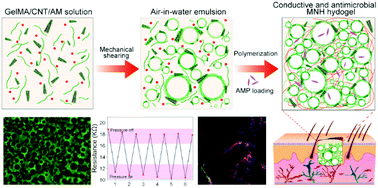
Biomater. Sci., 2020,8, 6957-6968
https://doi.org/10.1039/D0BM01466D
An alpha/beta chimeric peptide molecular brush for eradicating MRSA biofilms and persister cells to mitigate antimicrobial resistance
An α/β chimeric polypeptide molecular brush shows excellent performance in eradicating established biofilms, persister cells, and clinically isolated multi-drug resistant Gram-positive bacteria.
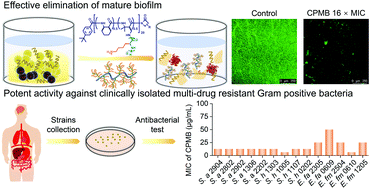
Biomater. Sci., 2020,8, 6883-6889
https://doi.org/10.1039/D0BM01211D
Combination of guanidinium and quaternary ammonium polymers with distinctive antimicrobial mechanisms achieving a synergistic antimicrobial effect
Synergistic killing of Gram negative bacteria by polymers that disrupt bacterial membranes and translocate and precipitate cytosolic proteins and nucleic acids.

Biomater. Sci., 2020,8, 6920-6929
https://doi.org/10.1039/D0BM00752H
A reduced polydopamine nanoparticle-coupled sprayable PEG hydrogel adhesive with anti-infection activity for rapid wound sealing
A novel sprayable PEG-PDA hydrogel adhesive can instantly gel to close wounds, providing synergistic antibacterial activities through ROS and hyperthermia.

Biomater. Sci., 2020,8, 6946-6956
https://doi.org/10.1039/D0BM01213K
A multifunctional shape-adaptive and biodegradable hydrogel with hemorrhage control and broad-spectrum antimicrobial activity for wound healing
An injectable hydrogel wound dressing based on an oxidized dextran and ε-poly-L-lysine network has multiple biological activities.
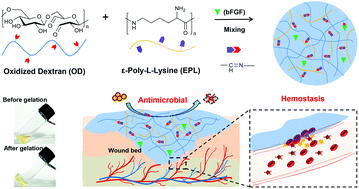
Biomater. Sci., 2020,8, 6930-6945
https://doi.org/10.1039/D0BM00800A
An on-demand nanoplatform for enhanced elimination of drug-resistant bacteria
We establish an “on-demand” nanoplatform based on acid-degradable scaffolds by conjugating glycomimetic-based galactose ligands to target a key lectin on P. aeruginosa and guanidine moieties.
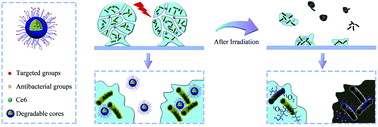
Biomater. Sci., 2020,8, 6912-6919
https://doi.org/10.1039/D0BM00786B
Amyloid-like protein aggregates combining antifouling with antibacterial activity
A new class of biopolymer coating based on amyloid-like protein aggregates is reported to combine both antifouling and antibacterial activity.
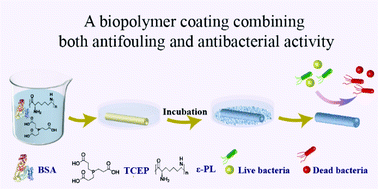
Biomater. Sci., 2020,8, 6903-6911
https://doi.org/10.1039/D0BM00760A
The synergistic effect of hierarchical structure and alkyl chain length on the antifouling and bactericidal properties of cationic/zwitterionic block polymer brushes
A well-organized hierarchical structure and appropriate alkyl chain length facilitate the synergistic anti-biofilm effect.
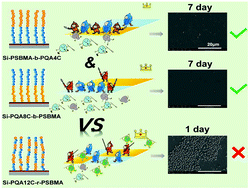
Biomater. Sci., 2020,8, 6890-6902
https://doi.org/10.1039/D0BM00903B
A natural polymer based bioadhesive with self-healing behavior and improved antibacterial properties
Bioadhesives are of great interest for tissue/wound closure to reduce surgical time, minimize treatment invasiveness, and prevent body fluid leakage.
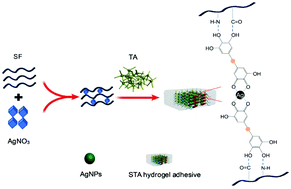
Biomater. Sci., 2020,8, 4346-4357
https://doi.org/10.1039/D0BM00624F
The rapid photoresponsive bacteria-killing of Cu-doped MoS2
This material of Cu doped MoS2 can produce reactive oxygen species and photothermal under 660 nm light, thus achieving a rapid bacterial effect. Which is a kind of good photothermal and photodynamic material.
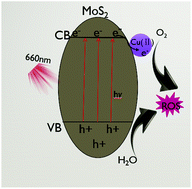
Biomater. Sci., 2020,8, 4216-4224
https://doi.org/10.1039/D0BM00872A
Amino-containing tannic acid derivative-mediated universal coatings for multifunctional surface modification
An amino-containing tannic acid derivative was self-polymerized to form colorless and uniform coatings on various substrate surfaces, and the resultant coatings can be further utilized to construct bioactive, antifouling and antibacterial surfaces.
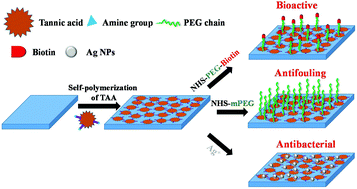
Biomater. Sci., 2020,8, 2120-2128
https://doi.org/10.1039/D0BM00242A
A dual-functional implant with an enzyme-responsive effect for bacterial infection therapy and tissue regeneration
An enzyme-responsive nanoplatform was fabricated on Ti substrates to treat implant-associated bacterial infection and accelerate tissue growth in vivo.
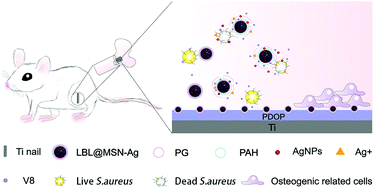
Biomater. Sci., 2020,8, 1840-1854
https://doi.org/10.1039/C9BM01924C